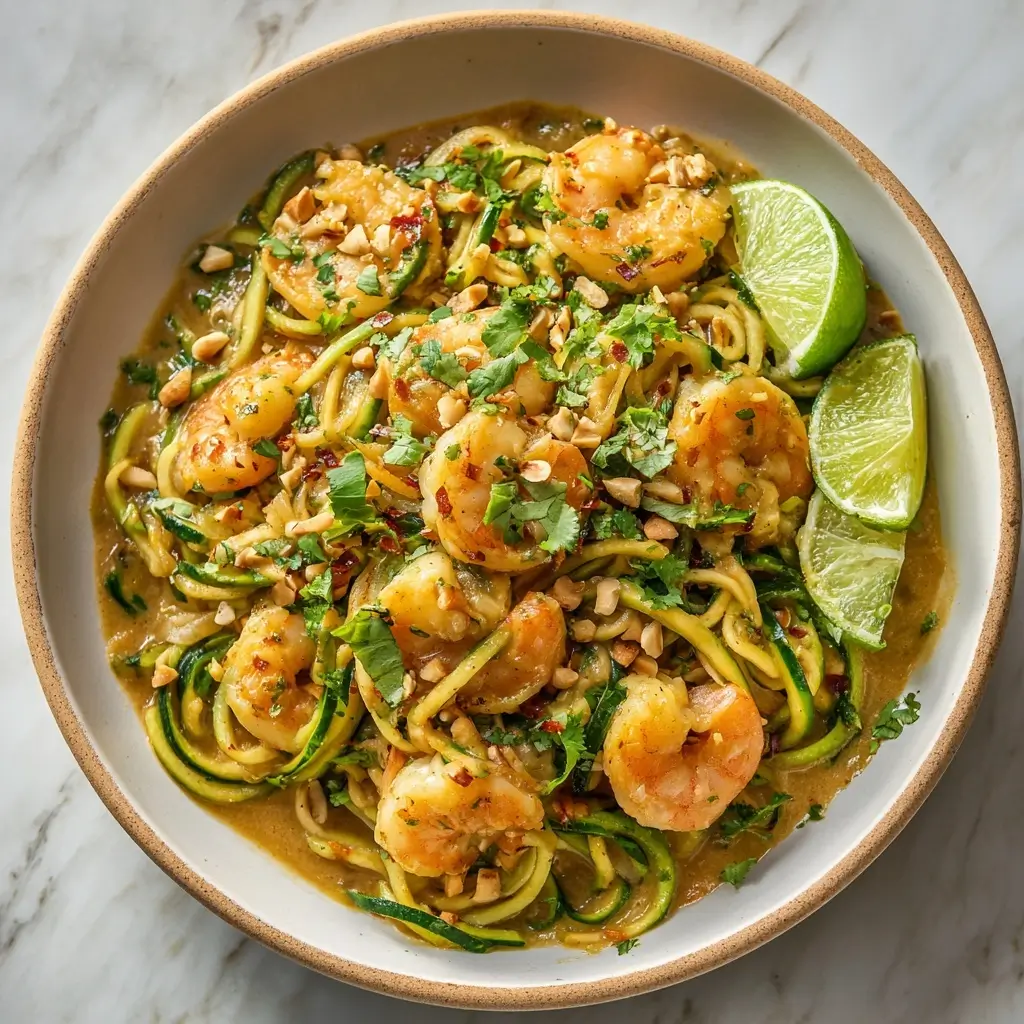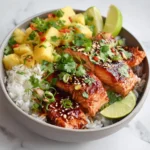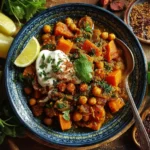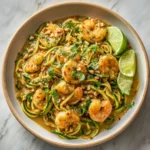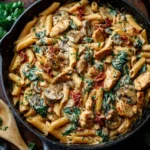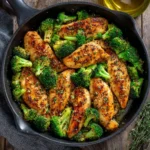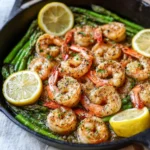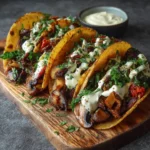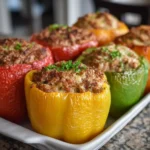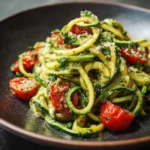Zucchini Noodle Pad Thai with Shrimp
If you’re looking for a vibrant, healthy twist on the classic Thai street food favorite, look no further than Zucchini Noodle Pad Thai with Shrimp. This low-carb, nutrient-rich version swaps traditional rice noodles for spiralized zucchini ribbons and packs in bold, tangy, umami-laden flavors that will transport your taste buds straight to Bangkok—without the heavy carbs or guilt. Perfect for weeknight dinners, meal prep, or impressing guests at a dinner party, this dish combines freshness, protein, and crunch in every bite.
The History
Pad Thai is one of Thailand’s most iconic dishes, believed to have been popularized in the 1930s during a national campaign to promote nationalism and unify Thai cuisine. Under the leadership of Prime Minister Plaek Phibunsongkhram, the government encouraged the consumption of stir-fried noodle dishes as a way to reduce rice consumption and create a distinct national identity. Over time, Pad Thai evolved into a beloved staple served by street vendors across the country and later around the world.
In recent years, health-conscious adaptations have emerged, including grain-free and low-carbohydrate versions using vegetable noodles. Zucchini noodles, or “zoodles,” became especially popular in the 2010s due to their ease of preparation and compatibility with paleo, keto, and gluten-free diets. By blending the authentic flavors of Pad Thai with modern wellness trends, Zucchini Noodle Pad Thai with Shrimp represents a delicious fusion of tradition and innovation.
Ingredients Breakdown
This recipe features a harmonious blend of fresh vegetables, lean protein, and a richly flavored sauce designed to mimic the sweet-sour-salty balance of traditional Pad Thai. Here’s what goes into it—and why:
- Zucchini: The star ingredient! Spiralized zucchini provides a light, noodle-like texture while contributing vitamins A and C, potassium, and fiber—all with minimal calories.
- Shrimp: A lean source of high-quality protein, rich in selenium, iodine, and omega-3 fatty acids. It cooks quickly and absorbs the sauce beautifully.
- Eggs: Adds creaminess and extra protein. Scrambled into the dish like in classic Pad Thai.
- Garlic and Shallots: Build aromatic depth and sweetness when sautéed.
- Red Bell Pepper: For color, crunch, and a boost of vitamin C.
- Snow Peas or Green Beans: Add freshness and a satisfying snap.
- Green Onions and Cilantro: Fresh herbs that elevate flavor and add brightness.
- Lime Juice: Essential for the signature tartness of Pad Thai.
- Fish Sauce: The umami backbone. Use a high-quality brand for best results.
- Tamarind Paste: Traditional sour agent. If unavailable, lime juice can substitute, though tamarind gives an authentic tang.
- Coconut Aminos or Soy Sauce (gluten-free option): Provides saltiness and depth. Coconut aminos are lower in sodium and sugar, ideal for paleo or soy-free diets.
- Maple Syrup or Coconut Sugar: Natural sweetener to balance acidity and salt.
- Avocado Oil or Coconut Oil: Healthy fats with high smoke points, perfect for stir-frying.
- Crushed Peanuts: For garnish—adds crunch and richness.
- Optional Add-ins: Red pepper flakes, bean sprouts, chili oil, or sesame seeds for heat and texture.
Step-by-Step Recipe
- Prepare the Zucchini Noodles: Using a spiralizer, spiralize 2 medium zucchinis into noodles. Place them in a colander, sprinkle lightly with sea salt, and let sit for 15–20 minutes to draw out excess moisture. Pat dry with paper towels or a clean kitchen towel. This step prevents a watery dish.
- Make the Pad Thai Sauce: In a small bowl, whisk together 3 tablespoons tamarind paste, 2 tablespoons coconut aminos, 1 tablespoon fish sauce, 1 tablespoon lime juice, 1 tablespoon maple syrup, and 1 teaspoon grated ginger. Adjust to taste—balance is key!
- Prep Ingredients: Peel and devein 12 oz (340g) of raw shrimp. Dice 1 small shallot and mince 2 cloves garlic. Slice 1 red bell pepper thinly. Cut snow peas diagonally. Chop green onions and cilantro. Set everything within reach.
- Stir-Fry the Aromatics: Heat 1 tablespoon avocado oil in a large non-stick skillet or wok over medium-high heat. Add shallot and garlic; sauté for 1–2 minutes until fragrant but not browned.
- Cook the Shrimp: Add shrimp to the pan in a single layer. Cook 1–2 minutes per side until pink and opaque. Remove and set aside.
- Add Vegetables: In the same pan, add another teaspoon of oil if needed. Toss in bell pepper and snow peas. Stir-fry for 2–3 minutes until crisp-tender. Remove and set aside with shrimp.
- Scramble the Eggs: Push any remaining veggies to the side, pour 2 beaten eggs into the pan, and scramble gently until just set. Break into small pieces.
- Combine Everything: Return shrimp and vegetables to the pan. Add the prepared zucchini noodles and the Pad Thai sauce. Toss gently but thoroughly using tongs or two spoons. Cook for 2–3 minutes until everything is heated through and well-coated. Avoid overcooking to keep zucchini from turning mushy.
- Finish and Garnish: Remove from heat. Stir in half of the chopped green onions and cilantro. Squeeze additional fresh lime juice if desired. Top with crushed peanuts, more herbs, and optional red pepper flakes.
- Serve Immediately: Plate hot, ideally in shallow bowls to showcase the colorful ingredients.
Tips
- Dry Your Zoodles: Moisture is the enemy of good texture. Salting and drying zucchini noodles ensures they don’t turn soggy when cooked.
- High Heat, Quick Cooking: Use a wok or large skillet over high heat to achieve that slightly charred, restaurant-style sear without overcooking delicate ingredients.
- Don’t Overcook the Zucchini: Add zoodles last and cook only until warmed through—about 2–3 minutes max.
- Prep Ahead: Chop all ingredients before starting. Stir-fries move fast!
- Customize the Sauce: Taste as you go. Want more tang? Add lime. More sweetness? A drizzle of honey. More umami? Extra fish sauce (sparingly!).
- Use Fresh Tamarind When Possible: While paste works well, reconstituted tamarind pulp offers a deeper, fruitier sour note.
- Leftover Storage: Store leftovers in an airtight container in the fridge for up to 2 days. Reheat gently in a skillet—microwaving may make zoodles watery.
Variations and Customizations
This recipe is incredibly adaptable based on dietary needs, preferences, or what’s in your pantry:
- Vegan Option: Omit shrimp and eggs. Use crumbled tofu or tempeh instead. Replace fish sauce with soy sauce or a vegan fish sauce alternative.
- Chicken or Beef Version: Swap shrimp for thinly sliced chicken breast or flank steak. Marinate in a bit of sauce before cooking for added flavor.
- Keto-Friendly: Use erythritol or monk fruit instead of maple syrup, and ensure coconut aminos are low-carb.
- Nut-Free: Skip peanuts and garnish with toasted sunflower or pumpkin seeds.
- Extra Veggies: Add shredded carrots, baby corn, mushrooms, or bok choy for more volume and nutrients.
- Spicier Kick: Stir in sriracha, chili garlic sauce, or fresh Thai bird chilies.
- Noodle Alternatives: Try yellow squash, sweet potato, or carrot noodles. Or mix zucchini with konjac (shirataki) noodles for a chewier texture.
- Cold Version: Chill ingredients and serve as a room-temperature noodle salad—perfect for summer picnics.
Health Considerations and Nutritional Value
Zucchini Noodle Pad Thai with Shrimp is a nutritionally balanced dish that supports various health goals:
- Low in Calories and Carbs: Compared to traditional Pad Thai (which can exceed 800 calories and 100g of carbs), this version typically comes in under 400 calories per serving with only 20–25g net carbs.
- Rich in Protein: Shrimp and egg provide about 25–30g of complete protein per serving, supporting muscle maintenance and satiety.
- Packed with Vitamins and Antioxidants: Zucchini, bell peppers, and herbs deliver vitamin C, beta-carotene, lutein, and flavonoids that support immune function and eye health.
- Heart-Healthy Fats: Avocado oil and optional avocado slices contribute monounsaturated fats, which help reduce bad cholesterol.
- Gluten-Free and Dairy-Free: Naturally suitable for those with sensitivities when using gluten-free tamari or coconut aminos.
- Omega-3s from Seafood: Shrimp contain beneficial omega-3 fatty acids, though less than fatty fish like salmon.
- Watch Sodium Levels: Fish sauce and coconut aminos can be high in sodium. Use reduced-sodium versions or dilute with water if needed, especially for those monitoring blood pressure.
- Allergen Note: Contains shellfish (shrimp) and peanuts (if used). Always inform guests of allergens present.
Ingredients
- 2 medium zucchinis, spiralized
- 12 oz (340g) raw shrimp, peeled and deveined
- 2 large eggs, beaten
- 1 small shallot, finely diced
- 2 cloves garlic, minced
- 1 red bell pepper, julienned
- 1 cup snow peas or green beans, trimmed and halved
- 3 green onions, sliced (white and green parts separated)
- 1/4 cup fresh cilantro, chopped
- 2 tbsp avocado oil or coconut oil, divided
- 1/4 cup unsalted roasted peanuts, crushed (optional)
- 1 lime, cut into wedges
- Sea salt, to taste
For the Pad Thai Sauce:
- 3 tbsp tamarind paste
- 2 tbsp coconut aminos (or gluten-free soy sauce/tamari)
- 1 tbsp fish sauce
- 1 tbsp pure maple syrup or coconut sugar
- 1 tbsp fresh lime juice
- 1 tsp freshly grated ginger
Directions
- Place spiralized zucchini in a colander, sprinkle with a pinch of sea salt, and let drain for 15–20 minutes. Gently press with paper towels to remove excess moisture.
- In a small bowl, whisk together all sauce ingredients: tamarind paste, coconut aminos, fish sauce, maple syrup, lime juice, and grated ginger. Set aside.
- Heat 1 tablespoon avocado oil in a large skillet or wok over medium-high heat. Add shallot and garlic; sauté 1–2 minutes until fragrant.
- Add shrimp in a single layer and cook 1–2 minutes per side until pink and opaque. Transfer to a plate.
- Add another teaspoon of oil if needed. Stir-fry bell pepper and snow peas for 2–3 minutes until crisp-tender. Remove and set aside with shrimp.
- Push ingredients to one side of the pan, add a little oil if necessary, then pour in beaten eggs. Scramble until softly set, then break into small pieces.
- Return shrimp and vegetables to the pan. Add zucchini noodles and sauce. Toss gently to coat evenly. Cook for 2–3 minutes until heated through.
- Remove from heat. Stir in half the green onions and cilantro. Taste and adjust seasoning—add more lime, sweetness, or fish sauce as desired.
- Divide into bowls. Garnish with crushed peanuts, remaining green onions, cilantro, and lime wedges.
- Serve immediately, encouraging diners to squeeze fresh lime juice over the top.
FAQ
Can I make this ahead of time?
Yes, but prepare components separately. Spiralize and drain zucchini up to a day in advance and store in the fridge. Make sauce 2–3 days ahead. Cook shrimp, eggs, and veggies just before assembling.
Why are my zucchini noodles watery?
This usually happens if moisture wasn’t removed. Always salt and drain zoodles before cooking. Also, avoid overcooking—heat them just until warm.
Is this recipe gluten-free?
Yes, as long as you use gluten-free tamari or coconut aminos instead of regular soy sauce.
Can I use frozen shrimp?
Yes, but thaw completely in the refrigerator overnight and pat dry before cooking to prevent steaming.
What can I use instead of tamarind?
A mix of lime juice and a touch of brown sugar can mimic tamarind’s sweet-sour profile, though it won’t be identical.
How do I store leftovers?
Keep in an airtight container in the refrigerator for up to 2 days. Reheat gently in a skillet over medium heat to preserve texture.
Can I bake this instead of stir-frying?
Not recommended. Baking will release too much water and result in a soggy dish. Stick to stovetop for best results.
Summary
Zucchini Noodle Pad Thai with Shrimp is a vibrant, low-carb reinvention of a Thai classic, combining tender shrimp, crisp vegetables, and spiralized zucchini in a perfectly balanced sweet-sour-umami sauce. Packed with flavor, nutrients, and ready in under 30 minutes, it’s a wholesome, satisfying meal that feels indulgent without the heaviness.
